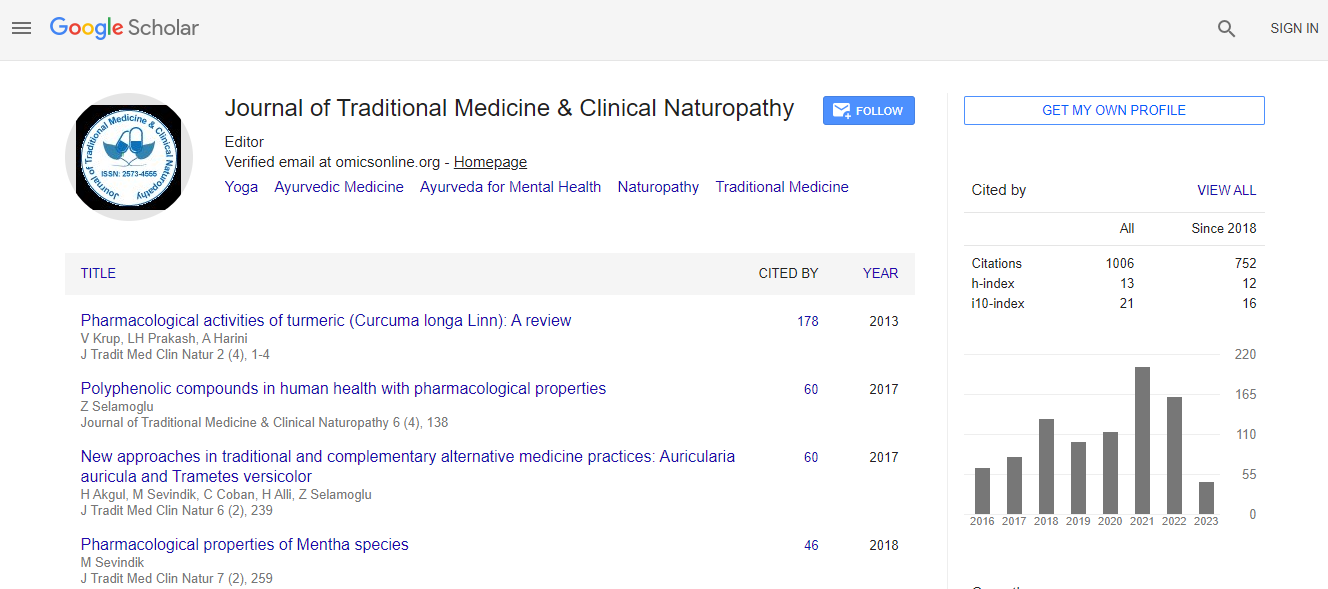Our Group organises 3000+ Global Conferenceseries Events every year across USA, Europe & Asia with support from 1000 more scientific Societies and Publishes 700+ Open Access Journals which contains over 50000 eminent personalities, reputed scientists as editorial board members.
Open Access Journals gaining more Readers and Citations
700 Journals and 15,000,000 Readers Each Journal is getting 25,000+ Readers
Google Scholar citation report
Citations : 1504
Journal of Traditional Medicine & Clinical Naturopathy peer review process verified at publons
Indexed In
- CAS Source Index (CASSI)
- Google Scholar
- Sherpa Romeo
- Open J Gate
- Genamics JournalSeek
- RefSeek
- Directory of Research Journal Indexing (DRJI)
- Hamdard University
- EBSCO A-Z
- Publons
- Geneva Foundation for Medical Education and Research
- Euro Pub
- ICMJE
Useful Links
Recommended Journals
Related Subjects
Share This Page
Phenolic contents, antioxidant activity and spectroscopic characteristics of Pterocarpus angolensis DC stem bark fractions
6th International Conference and Exhibition on Traditional & Alternative Medicine
Afsatou Ndama Traor├?┬ę, Anokwuru C P, Sigidi M T, Zininga T, Tshisikawe M P, Shonhai A, Ramaite I D I and Potgieter N
University of Venda, South Africa
ScientificTracks Abstracts: J Tradi Med Clin Natur
Abstract
Oxidative stress has been implicated in the damage of biological molecules resulting in aging and diseases such as Alzheimer, cancer, diabetes, cardiovascular disorders. The study aimed at determining the phenolic contents and antioxidant activities of Pterocarpus angolensis crude extracts and fractions. The crude extract and fractions of P. angolensis were evaluated for their phenolic contents. UV-Visible and FT-IR were used to assess the spectroscopic characteristics of the fractions obtained. The antioxidant activities were evaluated using 2, 2-diphenyl-1-picrylhydrazyl (DPPH) radical scavenging and reducing power assays. We obtained 7 fractions from the crude extracts after elution with various solvents on silica gel 60. The results showed that fraction two (PaF2a) displayed the highest DPPH radical scavenging activity (18.7 ├?┬╝g/ml) but the lowest phenolic content while fraction three (PaF2b) exhibited the highest reducing power activity (44.28 ├?┬╝g/ml) with high phenolic content. Spectroscopic details showed that PaF2a had maximum absorbance at 287.1 nm while PaF2b displayed maximum absorbance at 288.2 nm. The infra-red spectroscopy showed a slight difference in the intensity of the spectra of PaF2a and PaF2b. This study has shown that PaF2a and PaF2b are the antioxidant rich fractions of P. angolensis stem bark and exhibited different spectroscopic characteristics.Biography
Afsatou Ndama Traoré holds an MSc and a PhD in Biochemistry from the University of Johannesburg after undergraduate studies at the University Joseph Fourier (Grenoble I) in France. Her PhD research focused on the effect of iron overload on co-infection with HIV and TB – in vitro. This was a continuity of a large broader study, which had several phases looking at factors contributing to HIV infectivity as well as the development of an effective vaccine. Her research interest is the study of immunological responses to plants and infections.
Email: afsatou.traore@univen.ac.za

 Spanish
Spanish  Chinese
Chinese  Russian
Russian  German
German  French
French  Japanese
Japanese  Portuguese
Portuguese  Hindi
Hindi 
